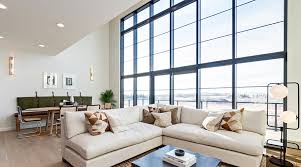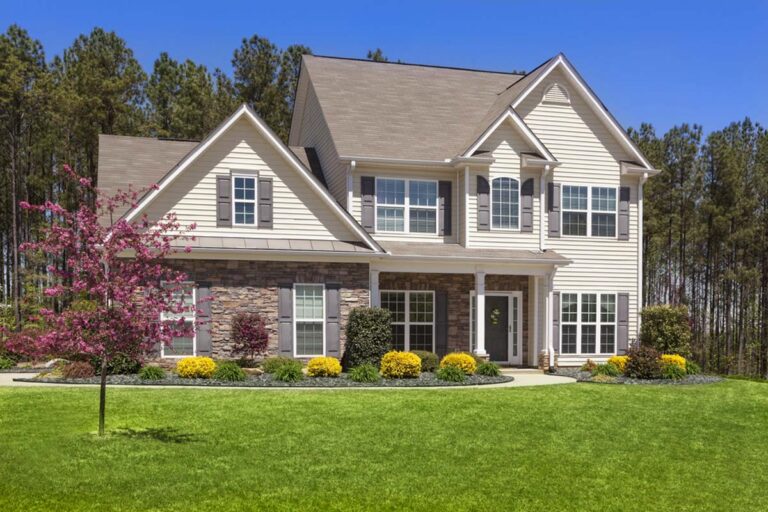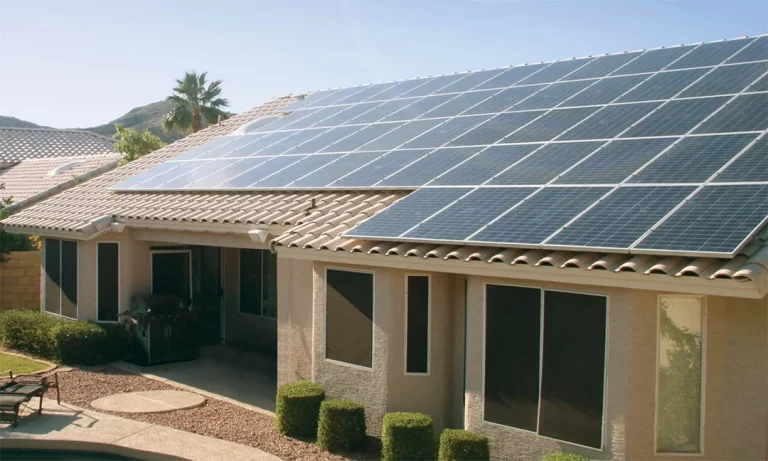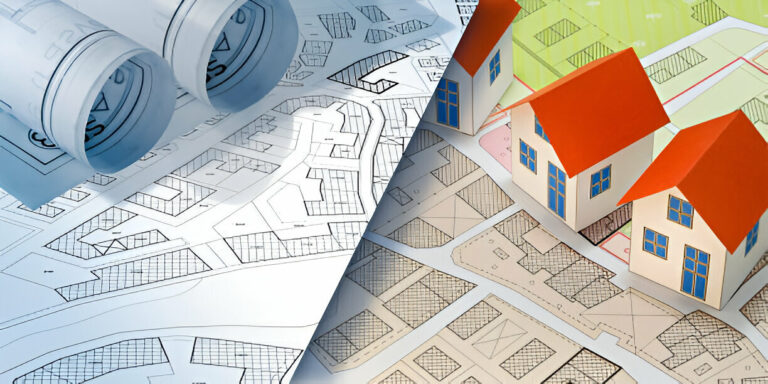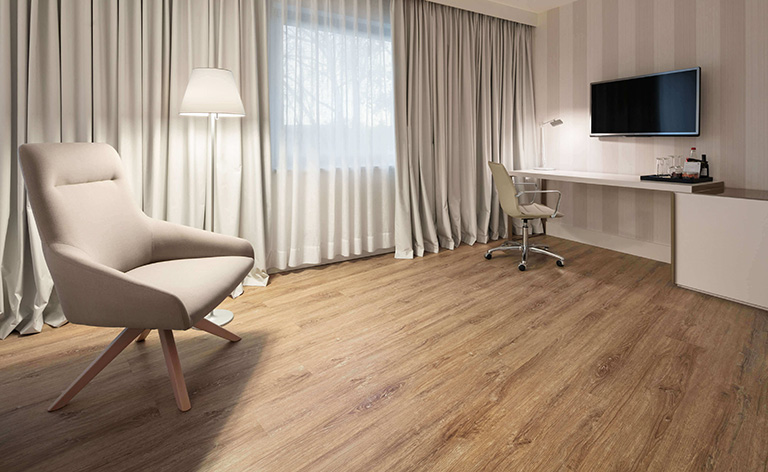Maximizing Natural Light: Window Placement Strategies for Custom Homes
To maximize natural light in your custom home, you’ll want to take into account the sun’s path throughout the day. Positioning your main living spaces south-facing guarantees ample sunlight, particularly useful in the northern hemisphere. Opt for larger windows strategically placed to catch morning light in east-facing rooms like your bedroom and kitchen, and the softer afternoon light in west-facing dining areas. Utilizing a variety of window shapes and sizes not only enhances the aesthetics but also the functionality, distributing light effectively throughout your home. Reflective surfaces and skylights can further boost light in dimmer areas. Discover how more integrated strategies could increase the benefits you enjoy.
Understanding Sun Path Basics
Understanding how the sun travels across the sky is vital when deciding where to place windows in your custom home. As the sun rises in the east and sets in the west, windows on these sides capture morning and evening light, respectively. But, don’t forget, the sun’s path shifts with the seasons.
In summer, it rises earlier, sets later, and reaches higher in the sky, potentially leading to overheating if you’re not cautious. Conversely, in winter, shorter days and a lower sun path mean less direct sunlight enters your home. Strategic placement of windows can maximize natural light while minimizing risks like UV exposure and excessive heat gain.
You’ll want to take into account adding larger, well-insulated windows on the south side of your home to take advantage of the consistent light throughout the year. These windows can help keep your home warm during the colder months while ensuring it remains bright and inviting.
Ensure these windows are equipped with energy-efficient glazing and frames to maintain indoor comfort and reduce heating and cooling costs. Safety glass is also vital to prevent injuries in case of accidental breakage. By understanding the sun’s path, you’re not just illuminating spaces; you’re enhancing the safety and efficiency of your home.
Home Orientation and Sunlight
Choosing the right orientation for your home greatly impacts how much sunlight it receives throughout the day. You’ll want to align your living spaces to make the most of the sun’s path, especially if you enjoy natural warmth and light.
Consider the sun’s trajectory: in the northern hemisphere, southern exposures receive the most sunlight. Orienting your main living areas to the south guarantees they’re bathed in light for most of the day. This isn’t just pleasant—it’s also energy-efficient, reducing the need for artificial lighting and heating.
Here’s a quick guide to help you visualize the benefits of proper orientation:
| Room | Ideal Orientation |
|---|---|
| Living Room | South-facing |
| Kitchen | South or East-facing |
| Bedroom | East-facing |
| Dining Room | West-facing |
| Study/Home Office | North or East-facing |
Each orientation serves a purpose: bedrooms facing east wake you with morning light, while west-facing dining rooms capture the evening glow. North-facing rooms, often cooler, are perfect for spaces like studies where indirect light minimizes glare on screens.
Strategic Window Sizing
When selecting windows for your custom home, size matters as much as placement. You’ll want to guarantee that the sizes you choose not only enhance the aesthetic of your home but also promote safety and functionality. Larger windows can flood your space with natural light, reducing the need for artificial lighting and can help save on energy costs. However, it’s essential to take into account the balance between large windows and your home’s structural integrity.
Opt for sizes that complement each room’s purpose. For instance, bedrooms might benefit from smaller, strategically placed windows that secure privacy while still allowing natural light. Living areas, on the other hand, could have larger windows to create an open, airy feel.
Safety is also paramount. Confirm that the materials and installation of large windows meet local building codes and safety standards. Reinforced glass and proper framing are pivotal, especially in areas prone to severe weather.
Lastly, think about maintenance and cleaning. Larger windows can be more challenging to maintain, so choose sizes that you can realistically manage. Remember, the right window size not only adds to your home’s charm but also its safety and efficiency.
Shapes and Natural Light Optimization
Several window shapes can dramatically enhance how natural light flows into your custom home. When you’re designing your living spaces, consider how different shapes not only affect aesthetics but also influence light distribution. For instance, tall, narrow windows or clerestory windows can be strategically placed to capture morning or afternoon light effectively, directing it into deeper parts of your rooms.
Circular or arched windows add a unique character and diffuse light softly, reducing glare and creating a calming atmosphere. These shapes tend to scatter light more evenly, which can be particularly beneficial in spaces where you spend a lot of time and desire consistent, gentle illumination without harsh shadows.
Bay windows are another fantastic option. They extend beyond the wall, capturing light from multiple directions. This not only brightens the room but also enlarges the perceived space, making rooms feel larger and more inviting. Safety-wise, verify these protruding windows are well-supported and constructed with tempered glass to prevent accidents.
Skylight Placement Techniques
Incorporating skylights into your custom home design can greatly enhance natural illumination in darker areas. When you’re planning where to place skylights, it’s essential to take into account both the sun’s path and the architectural layout of your home. Position skylights on the roof’s slope that faces away from the harsh midday sun yet captures the gentle morning or late afternoon light. This strategy avoids overheating and minimizes UV exposure while still brightening up your space effectively.
Safety is paramount, so choose skylights made of tempered or laminated glass to reduce injury risk in case of breakage. Make certain they are professionally installed to prevent leaks and structural damage. It’s also wise to opt for models with built-in UV protection to safeguard your family and your furnishings.
Reflect on the room’s use below the skylight. For instance, placing a skylight above a kitchen island or bathroom can maximize task lighting, while in a bedroom, consider a placement that doesn’t directly face the sleeping area to avoid disruptive light early in the morning. With thoughtful placement, skylights not only illuminate your home naturally but also enhance its aesthetic and energy efficiency.
Utilizing Reflective Surfaces
Reflective surfaces in your home can play an essential role in maximizing natural light. By strategically placing mirrors, glossy floors, or metallic fixtures opposite or near windows, you’ll amplify the sunlight that enters your space. This isn’t just about making your rooms brighter; it’s about enhancing the overall ambiance without additional energy costs.
You’ll want to contemplate the placement of these reflective items carefully. Mirrors, for instance, should be positioned so they reflect natural light into darker corners or areas farther from windows. However, verify they’re not directly facing the sun at times when you’ll be in the room, as this can create glare that’s uncomfortable and potentially unsafe.
Using shiny tiles or high-gloss paint on walls can also effectively redistribute light. Choose lighter shades to increase their reflective properties, but avoid overly glossy surfaces in high-traffic areas where glare could lead to slips or falls. Safety first!
Lastly, reflect on the types of materials you use. Some materials not only reflect light but also retain heat, which might be beneficial in colder climates but less so in warmer ones. It’s about finding the right balance that suits your home’s design and your comfort.
Importance of Window Height
Choosing the right window height is essential for enhancing both the functionality and aesthetics of your custom home. You’ll want to reflect on how window placement affects not just the look of your house but also its livability. Properly positioned windows can maximize natural light and improve your home’s energy efficiency, which in turn can reduce your heating and cooling costs.
When you’re thinking about window height, safety is a key consideration, especially in homes with young children. Windows that are placed too low can pose a risk for falls, while those that are too high may be inaccessible in an emergency. Ideally, windows should be high enough to deter accidents but still reachable for escape routes.
Additionally, the height of your windows affects privacy. Higher windows allow light in while keeping prying eyes out, which is particularly important in bedrooms and bathrooms. But don’t just think about your current needs. Reflect on future uses of each room, as flexibility can enhance the long-term value of your custom home.
Selecting the Right Glass
After settling on the ideal height for your windows, it’s important to focus on the type of glass that best suits your needs. Selecting the right glass isn’t just about aesthetics; it’s essential for safety and functionality. You’ll want to take into account tempered glass, which is designed to break into small, blunt pieces that minimize the risk of injury. This type of glass is ideal for areas where safety is a concern, such as lower windows that are within easy reach or in high-traffic areas.
Another important factor is laminated glass. This consists of a layer of vinyl between two sheets of glass, offering extra protection as it holds together when shattered. This feature not only improves safety by preventing sharp shards from causing injury but also enhances security against break-ins.
For energy efficiency, look into low-emissivity (low-E) glass. It reflects heat while letting light pass through, helping to keep your home warmer in the winter and cooler in the summer. It’s a smart choice that can save on heating and cooling costs, while also protecting your interiors from UV damage.
Choosing the right glass involves balancing aesthetics, safety, and energy efficiency to create a comfortable, secure home environment.
Integrating Transitional Spaces
While selecting the right glass plays an essential role in the functionality and safety of your custom home, integrating changing spaces such as sunrooms, porches, and mudrooms can seamlessly blend the indoors with the outdoors. These shifting spaces not only enhance the aesthetic appeal of your home but also improve its functionality by providing safe, light-filled areas where you can enjoy the beauty of nature without compromising on comfort.
As you design these areas, consider their orientation carefully. A sunroom or porch facing south will capture maximum daylight throughout the year, making these spaces ideal for relaxation or social gatherings during cooler months. For safety, guarantee that the glass in these areas is tempered or laminated to reduce the risk of injury in case of breakage.
Additionally, incorporating overhangs or using tinted glass can help manage the intensity of natural light and heat, making the space comfortable year-round. Don’t forget to integrate sturdy, lockable doors and windows in these shifting areas to enhance security while maintaining easy access to outdoor spaces.
Balancing Light and Privacy
When designing your custom home, balancing light and privacy becomes essential, especially in living and sleeping areas. You’ll want to harness as much natural light as possible while guaranteeing your family’s privacy isn’t compromised. One effective strategy is the strategic placement of windows. Consider taller, narrower windows or skylights that let in sunlight without compromising privacy.
Positioning windows on the north and south sides of your house maximizes light exposure throughout the day without creating a fishbowl effect where outsiders can easily peer inside. For areas where privacy is a top priority, such as bathrooms or bedrooms, frosted or obscured glass can be a game-changer. These materials allow light to enter while obscuring the view from the outside.
Additionally, incorporating external shading solutions like landscaping or architectural features can provide both privacy and a control over light levels. Trees, shrubs, or trellises not only beautify your property but also act as natural privacy screens. Remember, the right window treatments, such as adjustable blinds or curtains, offer flexibility. They let you modify the amount of light and privacy according to different times of the day or your specific needs. Hence, combining these elements wisely will guarantee your home is a haven of comfort and security.

